Some background:The Mikoyan-Gurevich MiG-19 (Russian: Микоян и Гуревич МиГ-19) (NATO reporting name: "Farmer") was a Soviet second-generation, single-seat, twin jet-engined fighter aircraft. It was the first Soviet production aircraft capable of supersonic speeds in level flight. It was, more oe less, the counterpart of the North American F-100 Super Sabre, although the MiG-19 would primarily oppose the more modern McDonnell Douglas F-4 Phantom II and Republic F-105 Thunderchief over North Vietnam.
On 20 April 1951, OKB-155 was given the order to develop the MiG-17 into a new fighter called "I-340", which was to be powered by two Mikulin AM-5 non-afterburning jet engines (a scaled-down version of the Mikulin AM-3) with 19.6 kN (4,410 lbf) of thrust. The I-340 was supposed to attain 1,160 km/h (725 mph, Mach 1) at 2,000 m (6,562 ft), 1,080 km/h (675 mph, Mach 0.97) at 10,000 m (32,808 ft), climb to 10,000 m (32,808 ft) in 2.9 minutes, and have a service ceiling of no less than 17,500 m (57,415 ft).
The new fighter, internally designated "SM-1", was designed around the "SI-02" airframe (a MiG-17 prototype) modified to accept two engines in a side-by-side arrangement and was completed in March 1952.
Initial enthusiasm for the aircraft was dampened by several problems. The most alarming of these was the danger of a midair explosion due to overheating of the fuselage fuel tanks located between the engines. Deployment of airbrakes at high speeds caused a high-g pitch-up. Elevators lacked authority at supersonic speeds. The high landing speed of 230 km/h (145 mph) (compared to 160 km/h (100 mph) in the MiG-15), combined with absence of a two-seat trainer version, slowed pilot transition to the type. Handling problems were addressed with the second prototype, "SM-9/2", which added a third ventral airbrake and introduced all-moving tailplanes with a damper to prevent pilot-induced oscillations at subsonic speeds. It flew on 16 September 1954, and entered production as the MiG-19S.

Approximately 5.500 MiG-19s were produced, first in the USSR and in Czechoslovakia as the Avia S-105, but mainly in the People's Republic of China as the Shenyang J-6. The aircraft saw service with a number of other national air forces, including those of Cuba, North Vietnam, Egypt, Pakistan, and North Korea. The aircraft saw combat during the Vietnam War, the 1967 Six Day War, and the 1971 Bangladesh War.
All Soviet-built MiG-19 variants were single-seaters only, although the Chinese later developed the JJ-6 trainer version of the Shenyang J-6. Among the original "Farmer" variants were also several radar-equipped all-weather fighters and the MiG-19R, a reconnaissance version of the MiG-19S with cameras replacing the nose cannon in a canoe-shaped fairing under the forward fuselage and powered by uprated RD-9BF-1 engines with about 10% more dry thrust and an improved afterburner system.
The MiG19R was intended for low/medium altitude photo reconnaissance. Four AFA-39 daylight cameras (one facing forward, one vertical and two obliquely mounted) were carried. Nighttime operations were only enabled through flare bombs, up to four could be carried on four hardpoints under the wings, even though the outer "wet" pylons were frequently occupied by a pair of 800l drop tanks.

The MiG-19R was not produced in large numbers and only a few were operated outside of the Soviet Union. The NATO reporting name remained unchanged (Farmer C). A recon variant of the MiG-19 stayed on many air forces' agendas, even though only the original, Soviet type was actually produced. Czechoslovakia developed an indigenous reconnaissance variant, but it did not enter series production, as well as Chinese J-6 variants, which only reached the prototype stage.
One of the MiG-19R's few foreign operators was the Polish Navy. The Polish Air Force had received a total of 22 MiG-19P and 14 MiG-19PM interceptors in 1957 (locally dubbed Lim-7), and at that time photo reconnaissance for both Air Force and Navy was covered by a version of the MiG-17 (Lim-5R). Especially the Polish Navy was interested in a faster aircraft for quick identification missions over the Baltic Sea, and so six MiG-19R from Soviet stock were bought in 1960 for the Polish Navy air arm.
Anyway, Poland generally regarded the MiG-19 family only as an interim solution until more potent types like the MiG-21 became available. Therefore, most of the fighters were already sold to Bulgaria in 1965/66, and any remaining Farmer fighters in Polish Air Force Service were phased out by 1974.
The Polish Navy MiG-19R were kept in service until 1982 through the 3rd Group of the 7th Polish Naval Squadron (PLS), even though only a quartet remained since two Lim-7R, how the type was called in Poland, had been lost through accidents during the early 70ies. Ironically, the older Lim6R (a domestic photo reconnaissance variant of the license-built MiG-17 fighter bomber) was even kept in service until the late 80ies, but eventually all these aircraft were replaced by MiG-21R and Su-22M4R.
General characteristics: Crew: One
Length: 12.54 m (41 ft)
Wingspan: 9.0 m (29 ft 6 in)
Height: 3.9 m (12 ft 10 in)
Wing area: 25.0 m² (270 ft²)
Empty weight: 5,447 kg (11,983 lb)
Max. take-off weight: 7,560 kg (16,632 lb)
Powerplant: 2× Tumansky RD-9BF-1 afterburning turbojets, 31.9 kN (7,178 lbf) each
Performance: Maximum speed: 1.500 km/h (930 mph)
Range: 1,390 km (860 mi) 2,200 km with external tanks
Service ceiling: 17,500 m (57,400 ft)
Rate of climb: 180 m/s (35,425 ft/min)
Wing loading: 302.4 kg/m² (61.6 lb/ft²)
Thrust/weight: 0.86
Armament: 2x 30 mm NR-30 cannons in the wing roots with 75 RPG
4x underwing pylons, with a maximum load of 1.000 kg (2.205 lb);
typically only 2 drop tanks were carried, or pods with flare missiles
Das Modell:Was Subtiles, auch wenn's seltsam aussieht. Ich bin/war schon lange fasziniert von den teils bizarren Anstrichen, die auf Flugzeugen der polnischen Marine zu finden ist/war - und natürlich ein gutes Argument für ein Whif. Im Stapel fand sich eine alte MiG-19 von Kovozavody - was lag da näher, als zuzuschlagen...?
OOB ist zu simpel, zumal ich gerne Hintergrundstories zu den Modellen zusammentrage. Die MiG-19 war zwar in Polen im Einsatz, aber nur sehr beschränkt, man wartete auf die MiG-21. Dann fand ich die rein sovietische MiG-19R als Fotoaufklärer (die gab es
wirklich), und daraus lies sich eine gute Story basteln, und das Modell ließ sich auch recht einfach umbauen.
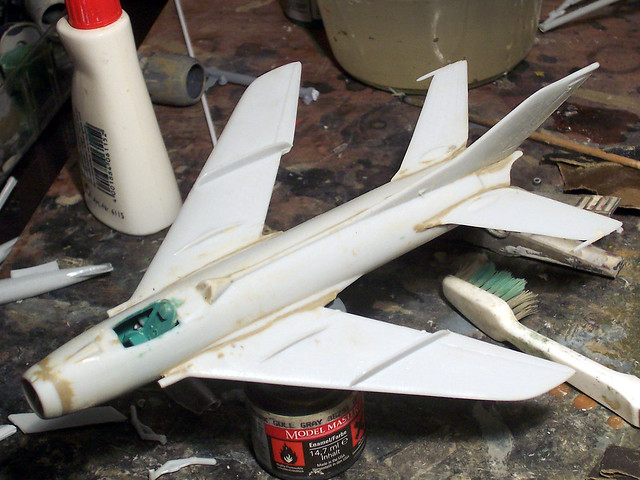
Der Basuatz an sich ist nicht übel - klar, tonnenweise Flash, mediokre Passform, teils etwas klobig (Räder, Kanonen, Sitz ist fast schon albern falsch), aber es ist alles da, um eine gute MiG-19 zu bauen, selbst die Antennen für den Radar-Höhenmesser sind als Teile dabei. Insofern wurde etwas gepimpt - neben dem Kamera-Gehäuse sind z. B. die Kanonen neu (aus Ohrstäbchen gebastelt...), im Heck wurden Nachbrenner implantiert (die man aber kaum sieht) und neue Räder kamen dran. Der Rest ist OOB, selbst die Zusatztanks.
Spaß kam erst beim Bemalen auf - Farben und Schema orientieren sich an realen Flugzeugen, selbst wenn's aussieht, als hätte ein sechsjähriger das Ding angemalt. Von oben sind es vier(!) Töne:
• Dunkelgrau Grey (FS 36118, Modelmaster)
• Dunkelgrün (RLM 71, Modelmaster)
• Hellblau (Fulcrum Green-Grey, Modelmaster)
• Grasgrün-Ochker (Humbrol 84 + Zinc Chromate, Modelmaster)
Von unten sit die Kiste Hellblau (FS 35414), die Markierungen sind aus diversen Quellen zusammengepuzzelt. Die Anti-Vogel-Augen sind ein weiteres, typisches Merkmal - und trägt zur bizarren Optik bei!
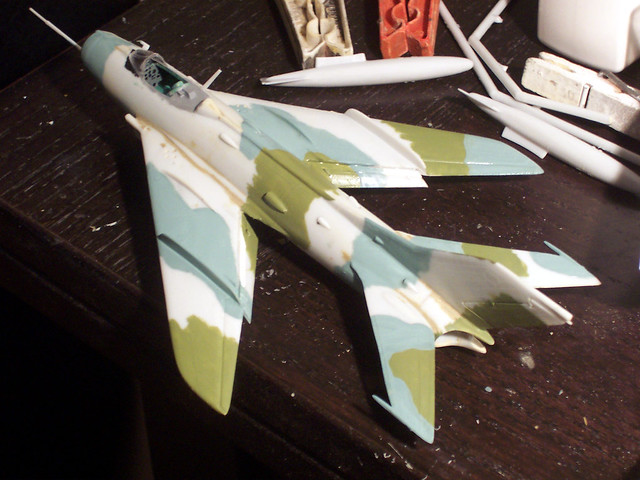

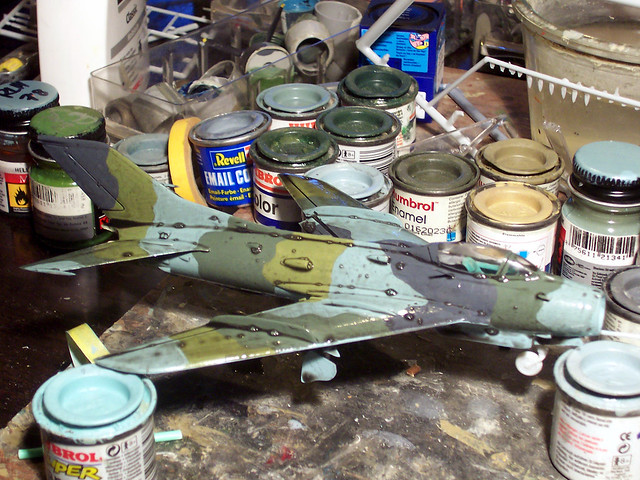
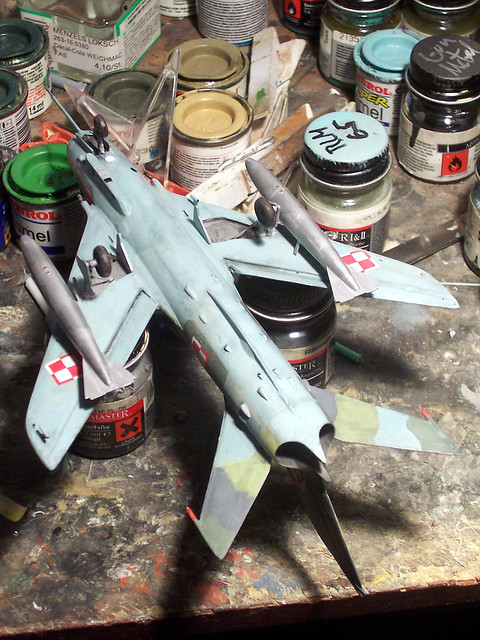
Um Konturen hervorzuheben kam ein leichtes Washing drüber und Trockenbemalung, zum Schluss eine Lage matter Klarlack.
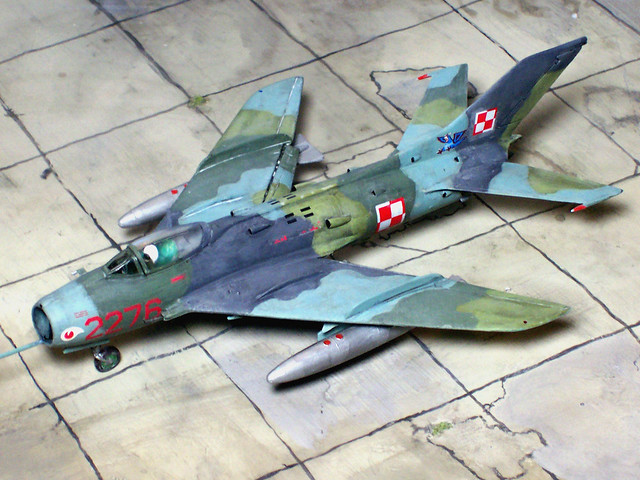
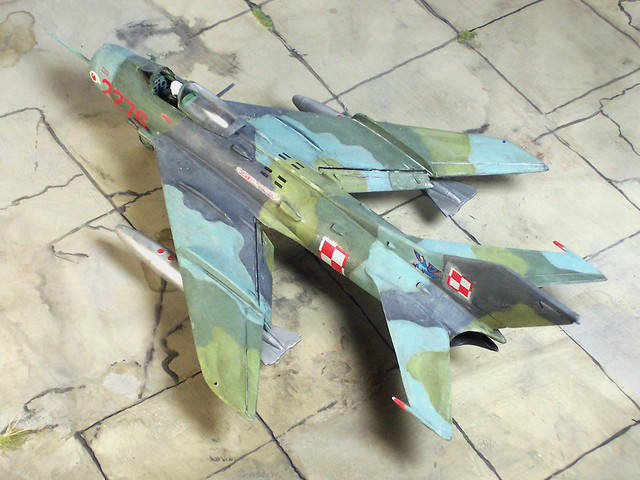
Simpel - aber effektiv, und gar nicht einmal so weit weg vom wahren Leben wie man denken mag...?